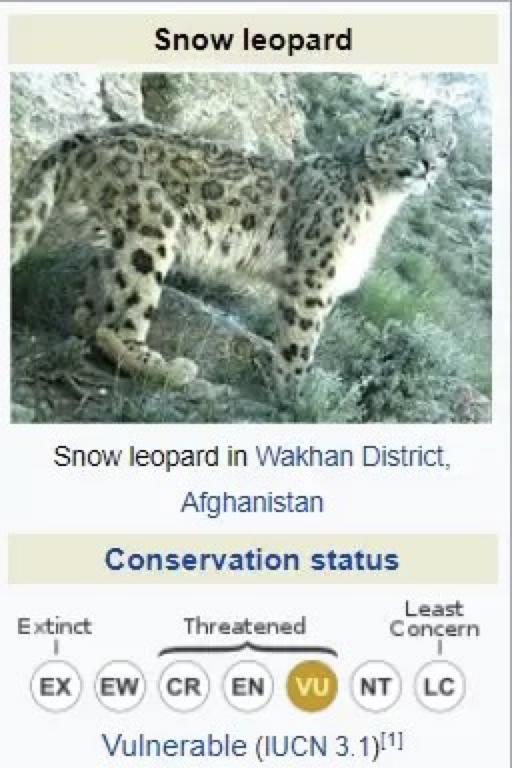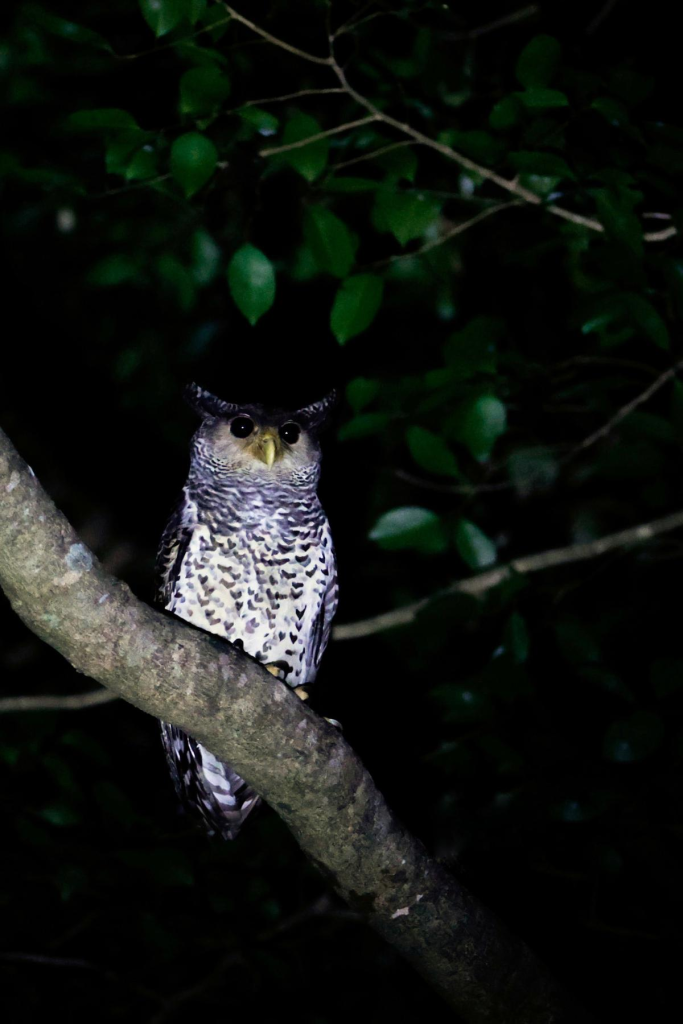CONTENT
- Snow Leopard
- Etalin Hydroelectric Project
- Bharat Pravah
- National Coal Index
- Spot Bellied Eagle Owl
Snow Leopard
Context:
Recently 4 snow leopards were spotted in a rare sighting in Himachal Pradesh.
Relevance:
GS III- Environment and Ecology
Dimensions of the Article:
- About the Snow leopard
- Snow Leopards in India and their conservation
About the Snow leopard

- The snow leopard is a large cat native to the mountain ranges of Central and South Asia.
- It is listed as Vulnerable on the IUCN Red List.
- The snow leopard, like all big cats, is listed on Appendix I of the Convention on International Trade of Endangered Species (CITES), which makes trading of animal body parts (i.e., fur, bones and meat) illegal in CITES signatory countries.
- Global population is estimated to number less than 10,000 mature Snow Leopards.
- It inhabits alpine and subalpine zones at elevations from 3,000 to 4,500 m.
- It is threatened by poaching and habitat destruction following infrastructural developments.
Snow Leopards in India and their conservation
- In India, their geographical range encompasses a large part of the western Himalayas including the states of Jammu and Kashmir, Himachal Pradesh, Uttarakhand and Sikkim and Arunachal Pradesh in the eastern Himalayas. The last three states form part of the Eastern Himalayas – a priority global region of WWF and the Living Himalayas Network Initiative.
- Project Snow Leopard (PSL): It promotes an inclusive and participatory approach to conservation that fully involves local communities.
- SECURE Himalaya: Global Environment Facility (GEF)-United Nations Development Programme (UNDP) funded the project on conservation of high-altitude biodiversity and reducing the dependency of local communities on the natural ecosystem. This project is now operational in four snow leopard range states, namely, Jammu and Kashmir, Himachal Pradesh, Uttarakhand, and Sikkim.
-Source: The Hindu
Etalin Hydroelectric Project
Context:
The Forest Advisory Committee (FAC) has recently asked the Arunachal Pradesh Government to review the Etalin hydropower project.
Relevance:
GS III: Infrastructure
Dimensions of the Article:
- About Etalin Hydroelectric Project (EHEP)
- Forest Advisory Committee (FAC)
- Idu-Mishmi Tribe
- Dibang River
About Etalin Hydroelectric Project (EHEP):
- A 3,097 MW hydropower project planned in the Dibang Valley of Arunachal Pradesh
- One of the largest hydropower projects in the country in terms of installed capacity
- Proposed to be developed as a combination of two run-of-the-river schemes
- Involves the construction of concrete gravity dams on the Tangon and Dri rivers, which are tributaries of the Dibang river
- Located in the “richest bio-geographical province of the Himalayan zone” and “one of the mega biodiversity hotspots of the world”
- The project area is dominated by indigenous population belonging to Idu-Mishmi tribes.
Forest Advisory Committee (FAC)
- Forest Advisory Committee (FAC) is a Statutory Body under the Ministry of Environment, Forests & Climate Change (MoEF&CC).
- FAC was constituted by the Forest (Conservation) Act, 1980.
- It plays an advisory role in questions on the diversion of forest land for non-forest uses such as mining, industrial projects, townships and advises the government on the issue of granting forest clearances.
Idu-Mishmi Tribe:
- They are the sole inhabitants of the Dibang Valley district in Arunachal Pradesh.
- A major sub-tribe of the Mishmi group.
- Mongoloid race with a distinct dialect of the Tibeto-Burman language.
- Distinctive hairstyle, customs, and artistic patterns on their clothing.
- Traditionally follow animism.
Dibang River:
- Flows through Arunachal Pradesh and Assam in India.
- An upstream tributary of the Brahmaputra.
- Originates near Keya pass on the Indo-Chinese border in the Upper Dibang Valley district of Arunachal Pradesh.
- Major tributaries include Sisar, Mathun, Tangon, Dri, Ithun, and Emra.
- The Mishmi Hills are found along the upper courses of the Dibang River.
Concerns Raised Around the Etalin Hydel Project:
Environmental Impact:
- The construction of a large dam on the Dibang River would submerge a significant area of forest and wildlife habitat.
- This could lead to displacement of local communities and significant impacts on the region’s biodiversity.
Displacement of Local Communities:
- Thousands of people would be displaced from their homes and livelihoods, many of whom are indigenous communities who rely on the Dibang River.
Impact on River Ecosystem:
- The project would change the natural flow of the river and affect fish migration and breeding, negatively impacting local communities who rely on fishing for their livelihoods.
Geological and Seismic Risks:
- The South Asia Network on Dams, Rivers and People (SANDRP) highlighted geological and seismic risks and threats to biodiversity in 2015, when environmental clearance (EC) was underway.
Recent Development of Issue:
- The Forest Advisory Committee (FAC) has asked the Arunachal Pradesh government to resubmit the project plan.
-Source: The Hindu
Bharat Pravah
Context:
Recently, the Ministry of Shipping, Waterways, and Ports has launched ‘Bharat Pravah-India along its Shores’, an initiative to highlight the significance and imagery of rivers, ports, and shipping in everyday life through a series of nationwide events.
Relevance:
GS III: Infrastructure
Dimensions of the Article:
- What is Bharat Pravah?
- Important Points related to Ports in India
What is Bharat Pravah?
- Bharat Pravah is a platform that brings together diverse stakeholders to develop a comprehensive vision for shipping, rivers, seas, and the people who rely on them.
- It aims to address challenges and policy issues, and establish future goals for the maritime sector.
Themes:
- Rivers and Sea-Centric Development in India- the Historical lens.
- Sea, River, Ports and Ship in Folk Culture and Literature.
- Representation of Ports and Shipping in Popular Culture.
- Role of Shipping and Ports in India’s Development in the last 30 years.
- The Politics and Economy of Privatisation of Ports.
- Inland Waterways – Arteries of Growth, their Role and Significance.
- Greening Ports and Shipping Industry.
- Future of Ports and Shipping Industry- Management, Challenges and Policies.
Important Points related to Ports in India
- The Indian government is working towards developing all ports into mega ports by 2047. Currently, a majority of India’s transshipment cargo is handled at ports outside of the country, with Colombo, Singapore, and Klang handling over 85% of this cargo.
- However, there are challenges in building these mega ports, including digitization and environmental concerns.
- Additionally, India’s containerization rate is lower compared to other developing countries, but progress is being made in this area.
- India’s participation in global trade is limited, with a 2% share, and a low ranking of 44 on the logistics performance index, due to inadequate infrastructure and lack of procedural reforms.
-Source: The Hindu
National Coal Index
Context:
The Ministry of Coal has launched the sixth round of commercial coal mines’ auction for 141 coal mines.
As per the provisions of the tender document, the Performance Bank Guarantee (PBG) to be submitted for each successfully auctioned coal mine is to be revised annually based on the National Coal Index (NCI).
Relevance:
GS II: Indian Economy
Dimensions of the Article:
- What is National Coal Index (NCI)?
- Components of NCI
- Implementation of NCI
What is National Coal Index (NCI)?
- The National Coal Index (NCI) is a price index established by the Ministry of Coal to determine revenue shares for the commercial auction of coal mines.
- It is based on market prices of coal and reflects changes in the price level of coal on a particular month relative to the fixed base year of FY 2017-18.
- The NCI is a composite of prices from all sales channels, including Notified Prices, Auction Prices, and Import Prices and is released every month.
- The base year for the NCI is FY 2017-18.
- It is used to arrive at the revenue share based on market prices of coal.
Components of NCI
- The National Coal Index (NCI) has been developed by the Indian Statistical Institute, Kolkata, and is composed of five sub-indices: three for Non-Coking Coal and two for Coking Coal.
- Composed of five sub-indices:
- Three for Non-Coking Coal
- Two for Coking Coal
- Sub-indices used to calculate separate indices for:
- Non-coking Coal
- Coking Coal
- Based on the grade of coal from a mine, the appropriate sub-index is used to determine the revenue share.
Implementation of National Coal Index (NCI)
- Revenue share per tonne of coal produced from auctioned blocks will be calculated using NCI through a defined formula
- The Index covers all transactions of raw coal in the Indian market including coking and non-coking of various grades transacted in the regulated (power and fertilizer) and non-regulated sectors
- Washed coal and coal products are not included in the Index.
-Source: The Hindu
Spot Bellied Eagle Owl
Context:
Recently, Spot Bellied Eagle Owl (Bubo Nipalensis) was spotted for the first time in Seshachalam forest, and for the third time in Andhra Pradesh.
Relevance:
GS III: Environment and Ecology
Dimensions of the Article:
- Spot-bellied Eagle Owl (also known as the Forest eagle-owl)
- IUCN and CITES Status
Spot-bellied Eagle Owl (also known as the Forest eagle-owl)

- A large owl species typically found in wooded areas such as forests and rocky hillsides.
- Known for their distinctive spots on their belly
- Large, powerful and bold predatory birds
- Known for its strange scream that resembles a human, called “Ghost of the Forest” in India.
- Found in India, Sri Lanka, Nepal, Bhutan, Bangladesh, Myanmar, China, Thailand, Laos, Cambodia and Vietnam.
- Known to prey on large birds and also on mammals such as golden jackals, hares, civets, and chevrotains.
IUCN and CITES Status:
- International Union for Conservation of Nature (IUCN) Red list: “Least Concern”.
- CITES (the Convention on International Trade in Endangered Species of Wild Fauna and Flora) : Appendix II.
-Source: The Hindu





